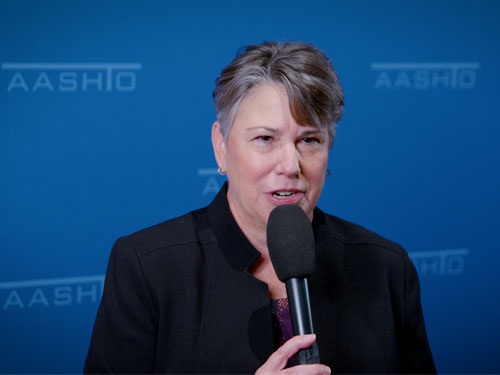The American Association of State Highway and Transportation Officials recently hosted a knowledge session at its 2024 Washington Briefing focused on helping transportation agencies navigate an “evolving” federal policy and regulatory landscape.
[Above photo by AASHTO]
“As we think about funding for federal transportation programs, it sometimes feels like we are on a roller coaster ride – especially in terms of where federal programs may or may not be going,” explained session moderator John Burton, senior vice president with engineering firm HNTB.

“We have to be vigilant regarding how federal policy is changing and how that affects programs moving forward,” he added. “This has been a challenging environment for us – and that is why these conversations are so critical. We need to understand where the challenges are so we can all continue delivering transportation projects that help improve communities across the country. That is why there is urgency and expediency around this issue.”
Marc Williams, executive director of the Texas Department of Transportation, said part of that “urgency” is related to preparations now being made for the next five-year surface transportation reauthorization funding measure; the bill that will take up where the Infrastructure Investment and Jobs Act or IIJA, enacted in 2021, wraps up.
“It is not too early to begin thinking what the next [reauthorization] bill looks like and to assess what the current bill [the IIJA] has done,” he said. “We have to acknowledge the importance of the IIJA; the increase in transportation funding it made is critical.”

However, Williams noted that in some respects the IIJA limited the flexibility state transportation agencies enjoyed in relation to previous reauthorization measures and hopes future federal legislative efforts can bring that back.
“We lost some of the previous flexibility for states to move money from one [transportation] program to another with the IIJA – that, in my view, is not a beneficial thing,” he explained. “Each state and territory has different needs and our ability to have flexibility key. So we need to work to build more of that back into the next reauthorization; to streamline it and consolidate some of the new programs created by the IIJA to help future reauthorization [measure] be more nimble.”
Jared Perdue, secretary of the Florida Department of Transportation, pointed out that the “winds of change” in the transportation sector encompass more than just federal policymaking issues.
“We are dealing with some of the most significant changes as state DOTs, irrespective of federal legislation,” he said. “We are facing supply chain disruptions we’ve never dealt with before. The cost of commodities has been extremely volatile over the last three years. All of that places additional strain and pressure on our traditional ways of doing business.”
To successfully deal with all of those external challenges will require state DOTs to be more innovative and to build partnerships with both local communities and Metropolitan Planning Organizations or MPOs, Perdue added.

“We need to focus on funding levels to sustain infrastructure levels in this country yet maintain flexibility so we can still deliver the transportation infrastructure we’ve already planned for,” he said. “We need less regulation. Yes, we need to serve our constituents and do what we have to do to protect the environment. But it is time to go back and look at the processes we’ve been using – they are antiquated, dinosaurs at this point we need more flexibility so we can be more innovative.”
Randy Clarke, general manager and CEO of the Washington Metropolitan Transit Authority, echoed that call for change – especially where environmental regulations are concerned.
“We need more regulatory standardization across the country,” he stressed. “A lot of NEPA [National Environmental Policy Act] reform is needed – especially the process around public engagement. We must have urgency when the voters say ‘I want this done.’ Also, the more we ‘depoliticize’ infrastructure, the better; the more data we use, the better and the more we align our investments with our values, the better.”
Ashby Johnson, executive director of the Capital Area MPO for the region surrounding Austin, TX, pointed out that partnerships will be the key to addressing the uncertainties facing the transportation sector.
“One of our biggest successes is our relationship with TxDOT; they are hard at work delivering good projects for us,” he explained. “The biggest thing we focus on is building relationships. And we constantly work at that – it requires regular tending to in order to keep that going. Because when you regularly sit down with state and local agencies, you often find more agreements than disagreements.”
Still, navigating transportation policy issues – at both the state and federal levels – remains a hurdle. “What we need is more consistency and interpretation of regulations within states and from state to state. That’s been an issue for a long time,” Johnson said. “The IIJA brought a lot of money to the table, whether you talk about formula or discretionary grant funding, but an issue for us is matching that money. The trouble especially at the local level is matching those funds – we need to realize that.”
 Top Stories
Top Stories
USDOT Makes $1.5B Worth of BUILD Grants Available
December 19, 2025 Top Stories
Top Stories

